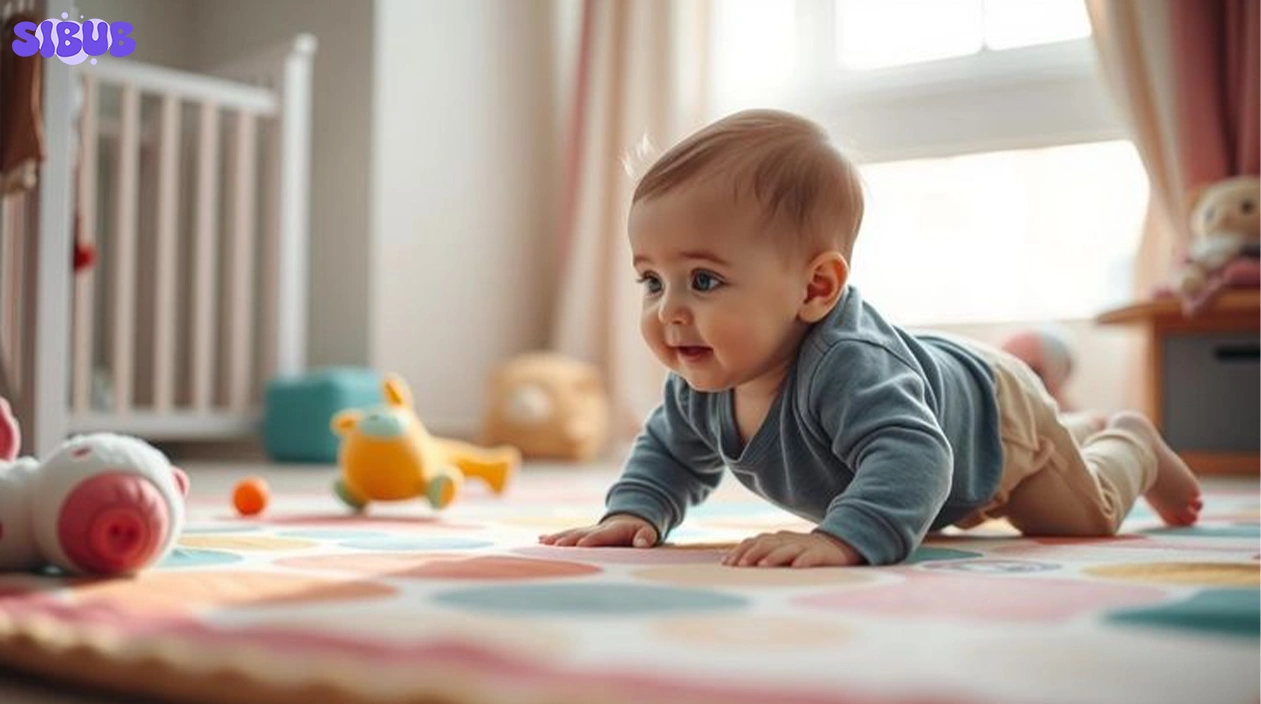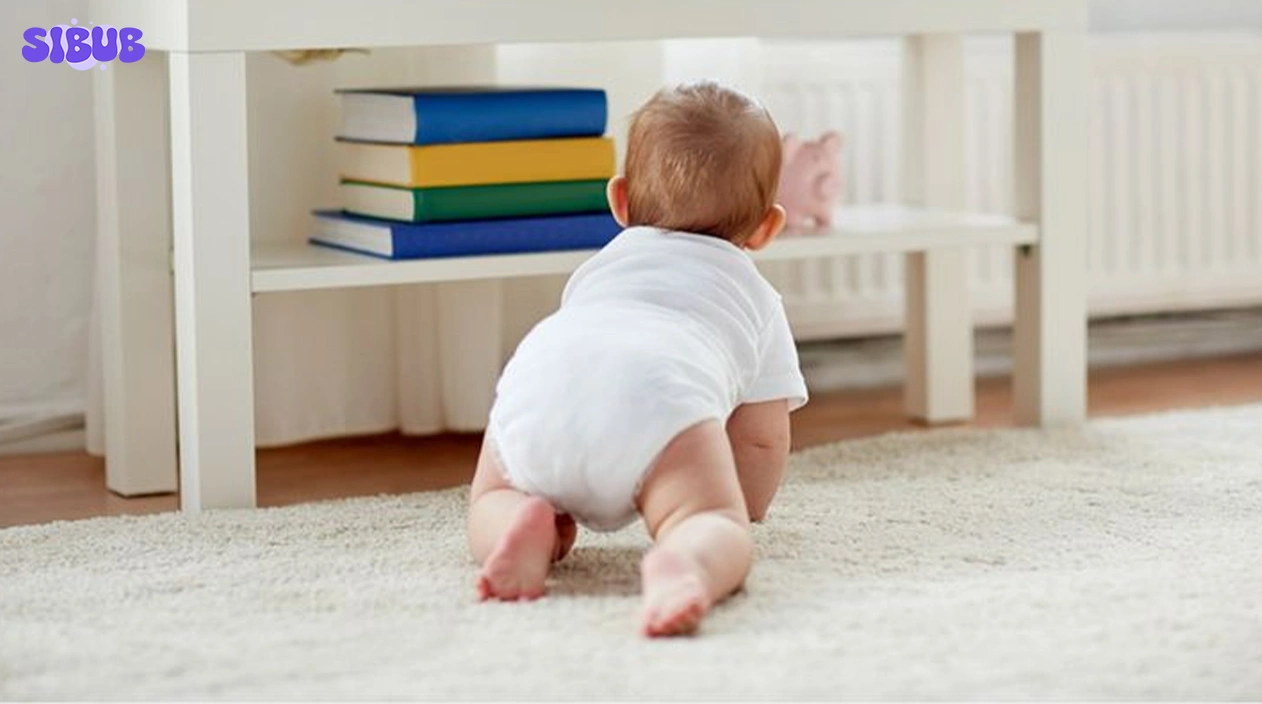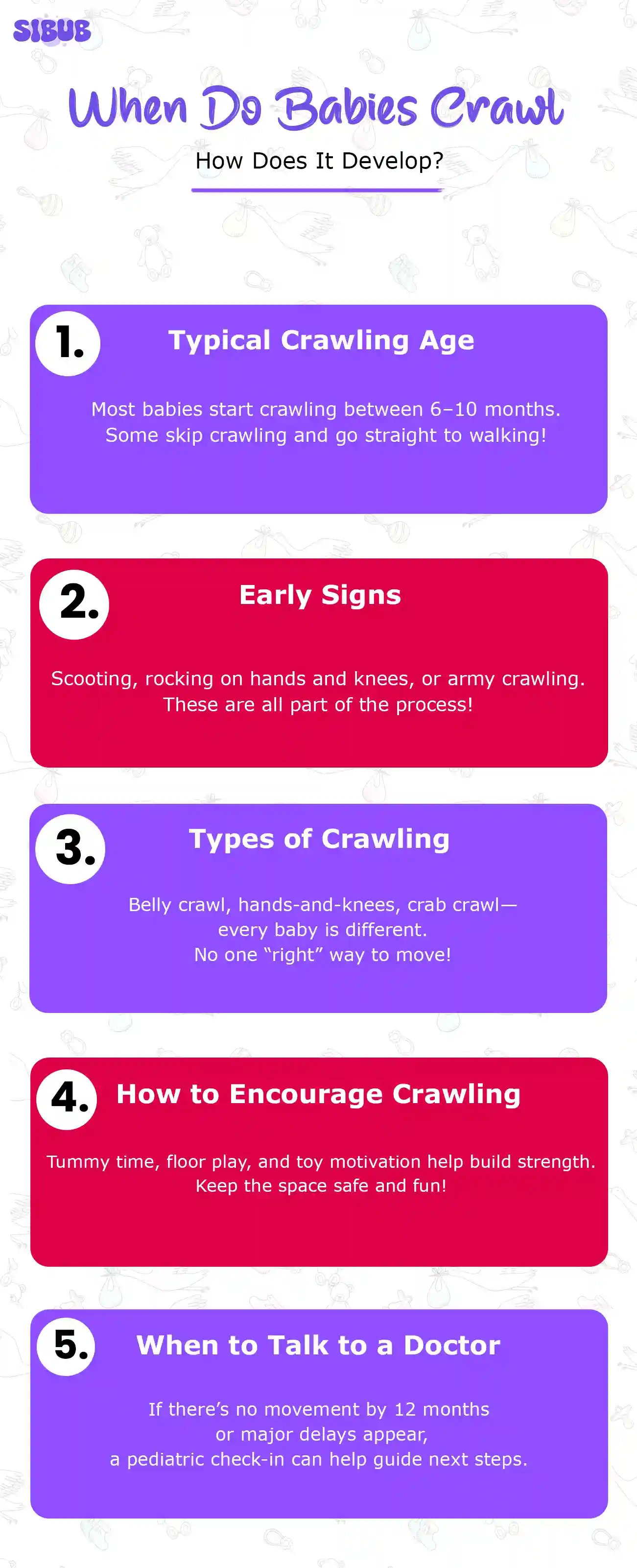Twinkle, twinkle little star, soon you’ll crawl near and far.
Crawling is one of the first big milestones in a baby’s life. But when exactly does a baby start crawling? The answer isn’t as simple as a single age or date. Crawling develops gradually through various infant crawling stages, and understanding the 7 stages of crawling helps parents recognize how their babies move and grow. In this article, we’ll explore the normal crawling age for babies, the steps of crawling, and what to expect along the way.
If you’re wondering when babies should crawl or what to do if your baby skips crawling, this guide will give you clear, evidence-based answers.
Why Is Crawling Important?
Crawling is not just about a baby moving from one spot to another spot. It actually builds muscles, coordination, balance, and even brain development. As babies learn to crawl, they develop motor skills. These skills set the stage for walking and other movements for your child.
But remember: not all babies crawl in the same way or at the same age. Some babies skip crawling entirely; they start moving directly. They use other ways to get around, and that can be perfectly normal.

Explore: Pomodoro Study Method—Boost Focus in Kids with ADHD
When Do Babies Start Crawling? The Basics
Most babies start crawling between 6 and 10 months. Multiple studies have shown that around 50% of babies start crawling by 8 months, but some babies start as early as 5 months. And above that, there can be children who wait until 11 months or maybe later to start crawling. And all these levels are perfectly fine.
That is why it can be said that crawling is not even on some official milestone lists anymore. This is because there’s so much variation in how babies move.
Now, another question arises: when does a baby start crawling?
The best answer is: it depends on the baby. Some crawl early, some later, and some never do the classic hands-and-knees crawl at all.
The 7 Stages of Crawling: How Crawling Develops
A baby goes through a complete series of motor skills. These skills ultimately led him to crawl. There are 7 stages of crawling:
- Tummy Time and Head Lifting. This is the first stage of baby crawling. It starts with a properly supervised tummy time. During this stage, babies learn to lift and hold their heads up. This procedure strengthens their neck as well as shoulder muscles.
- Rolling Over: This is the 2nd stage of a baby crawling. They roll both ways during this particular stage. Rolling from back to front and front to back helps a baby to gain control over their bodies and, ultimately, build their core strength.
- Sitting Up In the third stage, the babies start making efforts at sitting. Babies sitting without any support develop balance and also prepare themselves to shift weight during crawling.
- Rocking on Hands and Knees. The 4th stage of crawling is where the babies start rocking on their hands and knees. This stage is marked by the fact that before moving forward, babies often rock backwards and forwards on their hands and knees. They do this to practice balance.
- Belly Crawling Then begins the 5th stage, where a baby starts moving forward with the help of his/her belly. They begin crawling by dragging their bellies on the floor. This is generally called the “commando crawl” or “inchworm crawl.”
- Hands-and-Knees Crawling The 6th stage starts with the classic crawl. During this stage, the babies balance weight on hands and knees. This helps them lift their bellies off the ground and move forward.
- Cruising and Walking After mastering crawling, the 7th and last stage of crawling begins. The babies start pulling themselves up and moving while holding onto something, i.e, furniture or Mommy or Daddy. This is called cruising, which leads a kid to walk. After this stage is over, the baby will finally start walking independently.
These stages don’t always happen in this order, and some babies mix them or skip some steps entirely.

Learn More: What a Child Drawing Can Reveal About Home Life & Emotions
Exploring the Different Styles in Infant Crawling Stages
Babies have many ways of moving, and crawling styles vary widely. Here are some common crawling types you might see:
- Belly Crawling: Also known as the commando crawl. This is where the baby pulls with arms while his/her belly touches the floor. This stage is quite normal and often comes before hands-and-knees crawling.
- Hands-and-Knees Crawling: The traditional crawl where babies balance on their hands and knees with their belly off the floor.
- Bear Crawl: Crawling on hands and feet, with knees off the floor.
- Bottom Scooting: Moving by sitting and shuffling along on the bottom. Many babies use this method instead of crawling on hands and knees.
- Crab Crawl (Step-Scooting): Using one arm and both legs to move sideways, like a crab.
- Rolling: Some babies move by rolling from place to place before or instead of crawling.
- Cruising: Standing and moving sideways while holding furniture.
This variety highlights that crawling is not one-size-fits-all. Your baby might try one or several styles before moving on.
When Should Babies Crawl? What’s Normal?
The normal crawling age for babies ranges from 5 to 11 months, with the average around 8 months. Babies grow at their own pace, and many will reach crawling when their bodies and motivation are ready.
If your baby isn’t crawling by 12 months, it might be worth mentioning to your pediatrician, but no need to panic. Many babies skip crawling and still walk on time.
Parents can encourage crawling by giving babies plenty of tummy time on safe, soft surfaces. This helps babies strengthen muscles needed for crawling and build confidence.
Check this out: How to Play Charades: Rules for Kids
The Steps of Crawling: How Babies Learn to Move Forward
Crawling requires strength and coordination. Babies typically learn to:
- Lift their head and chest during tummy time.
- Push up on arms, strengthening shoulders.
- Rock back and forth on hands and knees.
- Shift weight and balance on hands and knees.
- Move arms and legs in coordinated patterns to propel forward.

Babies often experiment with moving forward but sometimes push backward first, a normal part of learning.
Parents can help by getting down on the floor, encouraging eye contact, and gently providing resistance behind the baby’s feet to encourage forward movement.
What Factors Affect When Babies Start Crawling?
Several things influence the timing and style of crawling:
- Body Type: Slimmer babies with less baby fat tend to crawl earlier because it’s easier to move their bodies.
- Tummy Time: Babies with more tummy time crawl earlier and develop motor skills faster (Kuo et al., 2008).
- Motivation: Some babies prefer staying upright or find crawling uncomfortable, so they choose other ways to move.
- Environment: Soft floor surfaces, unrestricted clothing, and safe play areas encourage crawling.
- Cultural Practices: In some cultures, crawling is less common because of clothing or parenting styles, leading babies to adopt different locomotion styles.
Should You Worry if Your Baby Doesn’t Crawl?
Not necessarily. Some babies skip crawling and go straight to walking. Research shows that babies who scoot or bottom-shuffle may walk just as well as crawlers (Storvold et al., 2013).
However, delayed crawling combined with other motor delays can be a sign of developmental issues. If your baby shows no signs of moving independently by 12 months or shows weakness on one side, consult your pediatrician.
Early intervention can help if there are motor development concerns.
Visit Sibub for more children-related blogs.
Summary: The 7 Stages of Crawling and What to Expect
- Crawling develops in stages, starting from tummy time and head lifting to cruising and walking.
- Babies show many crawling styles, from belly crawling to bottom scooting.
- Normal crawling age varies widely but generally falls between 5 to 11 months.
- Encouraging tummy time and providing a safe environment helps babies develop motor skills.
- Some babies skip crawling and still develop normally.
- Consult a pediatrician if your baby shows no progress in locomotion by 12 months or shows other motor problems.
